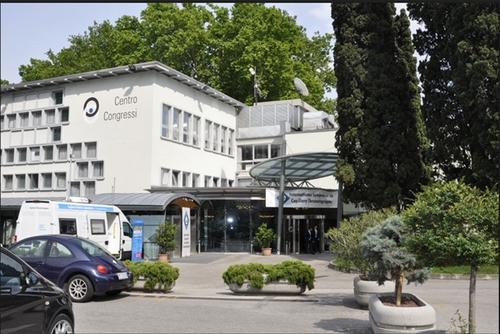
Markéta Vaculovičová
 38th International Symposium on Capillary Chromatography (ISCC) se společně s 11th GCxGC Symposiem uskutečnilo ve dnech 18. - 23. 5. 2014 v italském městečku Riva del Garda. Konference je zaměřena na separační techniky a to jak na chromatografické, tak elektromigrační metody. Celkem se účastnilo přibližně 1000 účastníků z celého světa. Posluchači měli možnost slyšet přednášky nejen předních českých vědců působících v zahraničí jako například Prof. Miloše Novotného (Indiana University, USA) nebo Prof. Františka Švece (Lawrence Berkeley National Laboratory, USA) ale také zahraničních odborníků v oblasti separačních věd jako například Prof. Paul Haddad (University of Tasmania, Australia), Prof. Daniel Armstrong (University of Texas at Arlington, USA), Prof. Robert Kennedy (University of Michigan, USA) nebo Prof. Janusz Pawliszyn (University of Waterloo, Canada). Všechny tyto osobnosti patří mezi 100 nejvlivnějších vědců v analytické chemii (https://theanalyticalscientist.com/the-power-list-2013/). Celkem bylo prezentováno 80 přednášek ve dvou paralelních sekcích a téměř 400 posterů.
Za naši skupinu byl formou posteru prezentován příspěvek s názvem: Detection of miR-124 as prostate cancer marker by capillary electrophoresis, který vznikl za finanční podpory grantu Excelentní mladí vědci na VUT CZ.1.07/2.3.00/30.0039
38th International Symposium on Capillary Chromatography (ISCC) se společně s 11th GCxGC Symposiem uskutečnilo ve dnech 18. - 23. 5. 2014 v italském městečku Riva del Garda. Konference je zaměřena na separační techniky a to jak na chromatografické, tak elektromigrační metody. Celkem se účastnilo přibližně 1000 účastníků z celého světa. Posluchači měli možnost slyšet přednášky nejen předních českých vědců působících v zahraničí jako například Prof. Miloše Novotného (Indiana University, USA) nebo Prof. Františka Švece (Lawrence Berkeley National Laboratory, USA) ale také zahraničních odborníků v oblasti separačních věd jako například Prof. Paul Haddad (University of Tasmania, Australia), Prof. Daniel Armstrong (University of Texas at Arlington, USA), Prof. Robert Kennedy (University of Michigan, USA) nebo Prof. Janusz Pawliszyn (University of Waterloo, Canada). Všechny tyto osobnosti patří mezi 100 nejvlivnějších vědců v analytické chemii (https://theanalyticalscientist.com/the-power-list-2013/). Celkem bylo prezentováno 80 přednášek ve dvou paralelních sekcích a téměř 400 posterů.
Za naši skupinu byl formou posteru prezentován příspěvek s názvem: Detection of miR-124 as prostate cancer marker by capillary electrophoresis, který vznikl za finanční podpory grantu Excelentní mladí vědci na VUT CZ.1.07/2.3.00/30.0039
Marketa Vaculovicova1, Kristyna Smerkova2, Vojtech Adam3,4 Rene Kizek1,2
1 Central European Institute of Technology Brno University of Technology - Brno University of Technology, Technicka 10, 61600 Brno, Czech Republic
2 Department of chemistry and biochemistry - Mendel University in Brno, Zemedelska 1, 61300 Brno,
Czech Republic
3 Central European Institute of Technnology - BUT - Brno University of Technology, Technicka 10, 61600 Brno, Czech Republic
4 Department of chemistry and biochemistry - Mendel Univerzity in Brno, Zemedelska 10, 613 00 Brno, Czech Republic
MicroRNAs (miRNA) are currently very promising markers of numerous diseases including diabetes, neurodegenerative diseases and cancer. Besides the diagnostic potential of these small non-coding RNA molecules, they may be utilized in gene therapy. Isolation by magnetic particles is nowadays proven to be an elegant and simple method for extraction of target molecule from complex biological mixture and therefore it is highly beneficial also for isolation of miRNA from the interfering matrix. In this work, a detection method for analysis of miR-124 (5-UAA GGC ACG CGG UGA AUG CCA), a prostate cancer marker, was developed. Capillary electrophoresis with light emitting diode induced fluorescence detection (CE-LEDIF, excitation – 400 nm, emission - 520 nm) was utilized to optimize the fluorescamine labeling procedure. Detection limits of this derivatization approach reached 10 nM (RSD 12.3%) of miR-124 standard and the calibration curve exhibited good linearity expressed as R2 = 0.9988. The separation was carried out in 20 mM sodium borate buffer (pH 9.2) using separation voltage of +20 kV and sample was injected by 2 psi for 5 s. Finally, streptavidin-modified magnetic particles were coupled to the DNA probe complementary to the target miRNA (5-Biotin-TGG CAT TCA CCG CGT GCC TTA) using the streptavidin-biotin interaction. Targeted miRNA was hybridized with the probe for 40 minutes in the hybridization solution (0.2 M sodium phosphate + 0.6 M guanidinium thiocyanate + 0.15 M Tris-HCl (pH 7.5) + 0.5 M NaCl). By utilization of these magnetic particles, miR-124 was extracted from the sample and subsequently eluted by the elevated temperature. Single-stranded miR-124 molecule was fluorescently labeled by fluorescamine which interacts with primary amine groups and the derivatized miRNA was analyzed by developed CE-LEDIF method. Acknowledgement The author M.V. wishes to express her thanks to project CZ.1.07/2.3.00/30.0039 for financial support.